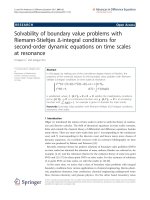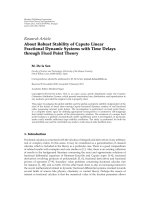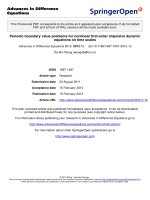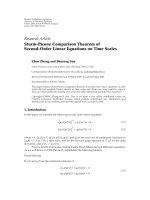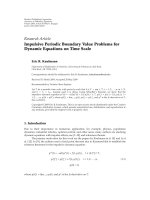- Trang chủ >>
- Thạc sĩ - Cao học >>
- Luật
Robust stability of implicit dynamic equations on time scales
Bạn đang xem bản rút gọn của tài liệu. Xem và tải ngay bản đầy đủ của tài liệu tại đây (604.25 KB, 11 trang )
VNU Journal of Science: Mathematics – Physics, Vol. 35, No. 4 (2019) 22-32
Original Article
Robust Stability of Implicit Dynamic Equations
on Time Scales
Nguyen Thu Ha*
Electric Power University, 235 Hoang Quoc Viet, Cau Giay, Hanoi, Vietnam
Received 21 October 2019
Accepted 30 October 2019
Abstract: This paper studies the robust stability of implicit dynamic equations on time scales,
which is a general form of differential algebraic equations and implicit difference equations. The paper
discusses the reservation of exponential stability of these equations under small Lipschitz perturbations.
Keywords: Uniform stability, time scales, implicit dynamic equations, Lipschitz perturbations.
1. Introduction
In lots of applications there is a frequently arising question, namely how robust is a characteristic
qualitative property of a system (e.g., the stability) when the system comes under the effect of
uncertain perturbations. The designer wants to have operation systems working stably under small
perturbations. Therefore, the investigation which conditions ensures robust stability play an important
role both in theory and practice. The classical problem studied the preservation of exponential stability
of the system y '(t ) By(t ) h(t , y) , where h(t , y) o( y) as y 0 or h(t,y) is Lipschitz continuous.
Next, this problem develops for the difference equation y(n 1) By(n) h(n, y(n)) . To unify these
results, Tien and Du in [1] have considered the perturbed dynamic equation on time scale T
y (t ) B(t ) y(t ) q(t ), t a , t T. The aim of this paper is to continue studying the above
problems. We desire to study the robust stability of time-varying systems of implicit dynamic
equations (IDEs) in a general context. That is the implicit dynamic equation of the form
A (t ) y (t ) B(t ) y(t ), t a , t T,
________
Corresponding author.
Email address:
https//doi.org/ 10.25073/2588-1124/vnumap.4417
22
(1.1)
N.T. Ha / VNU Journal of Science: Mathematics – Physics, Vol. 35, No. 4 (2019) 22-32
23
where A(.), B(.) are continuous matrix functions defined on T [a, ) valued in nn . The
leading term A (t ) (rd-continuous) is supposed to be singular for all t a. If the system (1.1) is
subjected to an outer force q, then it becomes
A (t ) y (t ) B(t ) y(t ) q(t ), t a , t T,
(1.2)
If T then the IDE (1.2) becomes a time-varying differential-algebraic equation and if T
then it is a time-varying implicit difference equation. The differential-algebraic equations (DAEs) are
the mathematical models arising in various applications, such as multibody mechanics, electrical
circuits, prescribed path control, chemical engineering, etc., see [2, 3]. Similarly, the implicit
difference equations also occur in the different fields, such as population dynamics, economics,
systems and control theory, and numerical analysis, etc., see [4, 5]. Therefore, it is very meaningful to
have an equation combining these equations. Indeed, this can be done by the theory of dynamic
systems on an arbitrary time scale. This theory has been found promising because it demonstrates the
interplay between the theories of continuous time and discrete time systems, see, e.g. [6, 7]. By using
this theory, the IDE can be considered as a unified and connected form between the time-varying DAE
and the time-varying implicit difference equation. Thus, they play an important role in mathematical
modeling with many applications.
On the basis of the above discussion, it is worth considering the robust stability of these
equations. To study that, the index notion, which plays a key role in the qualitative theory and in the
numerical analysis of IDEs, should be taken into consideration in the robust stability analysis, (see [8,
9]). For the stability theory of time-varying linear DAEs, a few contributions are available (see [10,
11]). To develop from DAEs to IDEs, the results of the paper are to derive some characterizations for
the robust stability of IDEs subjected to Lipschitz perturbations.
The paper is organized as follows. In the next section we recall some basic notions and
preliminary results on time scales and deal with the solvability of IDEs. In Section 3, we prove that if
the system (1.1) is exponentially stable, then under small Lipschitz perturbations, the system (1.1) is
still exponentially stable. In the end of this paper, we also give the example to illustrate the theorem in
Section 3.
2. Solvability of implicit linear dynamic equations on time scales
In recent years, to unify continuous and discrete analysis or to describe the processing of
numerical calculation with non-constant steps, a new theory was born and is more and more
extensively concerned, that is the theory of the analysis on time scales, which was introduced by
Stefan Hilger 1988 (see [12]). A time scale is a nonempty closed subset of the real numbers
,
enclosed with the topology inherited from the standard topology on . We usually denote it by the
symbol T. We define the forward jump operator (t ) inf s T : s t and the graininess
(t ) (t ) t . Simi;ar;y, the backward operator is defined as (t ) sups : s t and the
backward graininess is (t ) t (t ). A point t T is said to be right-dense if (t ) t , rightscattered if (t ) t , left-dense if (t ) t , left-scattered if (t ) t and isolated if t is
simultaneously right-scattered and left-scattered.
A function f defined on T valuated in
is regulated if there exist the left-sided limit at every
left-dense point and right-sided limit at every right-dense point. A regulated function f is called rd-
24
N.T. Ha / VNU Journal of Science: Mathematics – Physics, Vol. 35, No. 4 (2019) 22-32
continuous if it is continuous at every right-dense point, and ld-continuousif it is continuous at every
left-dense point. The set of rd-continuous functions defined on the interval J valued in X will be
denoted by Crd J , X . A function f from T to
is regressive (resp., positively regressive) if for
every t T, then 1 (t ) 0 (resp., 1 (t ) 0 ). We denote by T,
(resp.,
T,
)
the set (resp., positively regressive) regressive functions, and Crd T, (resp., Crd T, ) the set
of rd-continuous (resp., positively regressive) regressive functions from T to . It is easy to verify
that, for all p, q , p q, pq . Element (q)(.) is called the inverse element of element
q(.) .Hence, the set T,
with the calculation forms an Abelian group.
Definition 1.1 ([12]). (Delta Derivative). A function : T
d
is called delta differentiable at t if
there exists a vector (t ) such that for all ε >0,
( (t )) ( s) (t ) s (t ) s ,
for all s (t , t ) T and for some δ >0. The vector (t ) is called the deltaderivative of at t.
Theorem 1.2 ([12]). If p is regressive and fix t0 T , then the only solution of the initial value
problem
y (t ) p(t ), y(t0 ) 1,
on T is definedby e p (t , t0 ), where
t
Ln(1 up( ))
e p (t , t0 ) exp lim
.
u ( )
u
t0
The further details on the analysis on time scales can be referred to [12].
On the language of analysis on time scales, the linear algebraic differentiable equation
A (t ) y '(t ) B(t ) y(t ) q(t ), t a ,
and the implicit difference equation
An1 (t ) y(n 1) B(n) y(n) q(n), n a ,
can be unified under the form, called the time-varying linear IDE on time scale T
A (t ) y (t ) B(t ) y(t ) q(t ), t a ,
(2.1)
where A, B are continuous matrix functions as in Section 1, i.e. rank A(t ) r, 1 r n , for all t Ta
and q is a continuous function defined on Ta , valued in
n
.
Firstly, we consider the solvability of the IDE (2.1). Assume that Ker A(t ) is smooth in the sense
there exists an continuously differential projector Q(t ) onto Ker A(t ) , i.e., Q C1 (Ta , nn ). Set
P I Q , then P(t ) is a projector along Ker A(t ) . With these notations, the system (2.4) can be
rewritten into the form
A (t ) Py (t ) B (t ) y(t ) q(t ),
where B B A P Lloc T,
nn
.
(2.2)
N.T. Ha / VNU Journal of Science: Mathematics – Physics, Vol. 35, No. 4 (2019) 22-32
Let H be a continuous function defined on Ta , taking values in Gl (
n
) such that H
25
KerA
is an
isomorphism between Ker A (t ) and Ker A(t ). Define G A BHQ and S y : By Im A .
Lemma 2.2 The following assertions are equivalent
a)
S KerA 0 ;
b) The matrix G A BHQ is nonsingular;
c)
n
S Ker A ;
Proof See [13, Lemma 2.1].
Lemma 2.3 Suppose that the matrix G is nonsingular. Then, there hold the following relations:
a) P G 1 A ;
b) G 1BHQ Q ;
c) Q Q G 1 B is the projector onto KerA along S;
If Qˆ is a projector onto KerA then
d) P G 1B P G 1BPˆ , and Q G 1B Q G 1BPˆ H 1Qˆ , with Pˆ I Qˆ .
e) P G 1 , HQ G 1 do not depend on the choice of T and Q.
Proof See [13, Lemma 2.2].
Definition 2.4 (see also [6, Section 1.2]) The DAE (2.1) is said to be index-1 tractable on T if G(t ) is
invertible for almost every t T.
Now let (2.1) be index-1. Multiplying both sides of (2.2) with P G 1 , Q G 1 respectively, we can
decouple the index-1 equation (2.1) into the system
1
1
( Py ) ( P P G B) Py P G q
1
1
Qy HQ G BPy HQ G q.
Denote u Py, v Qy , we obtain
1
1
u ( P P G B)u P G q
1
1
v HQ G Bu HQ G q.
(2.3)
(2.4)
Multiplying both sides of (2.3) with Q yields Q u Q P u which implies that (Qu) QQu.
Hence, if Q(t0 )u(t0 ) 0 then Q(t )u(t ) 0 for all t Tt0 , i.e. the equation (2.3) has the invariant
property in the sense that every solution starting in Im P(t0 ) remains in Im P(t ) for all t.
We consider the homogeneous case q(t ) 0 ,
A (t ) y (t ) B(t ) y(t ), t a ,
(2.5)
and construct the Cauchy operator generated by (2.5). Let 0 (t , s) denote the Cauchy operator
generated by the equation (2.3), i.e.,
0 (t , s) ( P (t ) P (t )G 1B (t ))0 (t , s), and 0 (s, s) I .
N.T. Ha / VNU Journal of Science: Mathematics – Physics, Vol. 35, No. 4 (2019) 22-32
26
Then, the Cauchy operator generated by system (2.5) is defined by
A (t ) (t , s) B(t )(t , s),
P( s) ( s, s) I 0
for all t s a and it can be given as follows:
(2.6)
P(t )(t , s) P(t ) P(t )0 (t , s) P(s) P(t )0 (t , s) P(s) 0 (t , s) P(s).
(2.7)
(t , s) I HQ G 1 B 0 (t , s) P(s) P(t )0 (t , s) P(s),
where P(t ) I HQ G 1 B .
By the arguments used in [6, Section 1.2], the unique solution of the initial value problem for (2.1)
with the initial condition
P(t0 ) y(t0 ) y0 0,
t t0 ,
(2.8)
By the variation of constants formula, we have the unique solution of Equation (2.1) defined by
t
y (t ) (t , t0 ) P(t0 ) y0 (t , ( s)) P G 1q(s )ds HQ G 1q(t ).
(2.9)
t0
3. Robust stability of perturbed implicit dynamic equations on time scales
In the following, we suppose that, there exists a bounded differential projector Q(t) onto KerA(t )
and N0 sup P(t ) .
tTa
We consider the system (2.1) with perturbations of the form q(t ) f (t , y(t ))
where f is a certain function defined on Ta
n
. Then, the equation (2.1) becomes
A (t ) y (t ) B(t ) y(t ) f (t , y(t )),
t a.
(3.1)
Let f (t ,0) 0 for all t Ta , which implies that Equation (3.1) has the trivial solution x(t ) 0.
As before, denoting u = Py and v = Qy comes to
u P P G 1B (t ) u P G 1 f (t , u v),
v HQ G 1Bu HQ G 1 f (t , u v).
(3.2)
(3.3)
Assume that HQ G 1 f (t ,.) is Lipschitz continuous with the Lipschitz coefficient t 1, i.e.,
HQ G 1 f (t , y) HQ G 1 f (t , x) t y x , for all t a.
Since HQ G 1 does not depend on the choice of H and Q, so does the Lipschitz property of HQ G 1 f .
Fix u
m
and choose t Ta , we consider a mapping t : Im Q(t ) Im Q(t ) defined by
t (v) H (t )Q (t )G 1 (t ) B(t )u H (t )Q (t )G 1 (t ) f (t , u v).
It is easy to see that
t (u) t (v) t u v , for any for all v, v ' Im Q.
Since t 1, t is a contractive mapping. Hence, by the Fixed Point Theorem, there exists a mapping
gt : Im P(t ) Im Q(t ) satisfying
N.T. Ha / VNU Journal of Science: Mathematics – Physics, Vol. 35, No. 4 (2019) 22-32
27
gt (u) H (t )Q (t )G 1 (t ) B(t )u H (t )Q (t )G 1 (t ) f (t , u gt (u)).
(3.4)
On the other hand,
gt (u) gt (u ') t u u ' t u u ' gt (u ) gt (u ') ,
where t H (t )Q (t )G 1 (t ) B (t ) . This deduces
gt (u ) gt (u ')
t t
u u' .
1 t
Thus, g t is Lipschitz continuous with the Lipschitz coefficient Lt
t t
. Substituting v gt (u )
1 t
into (3.2) obtains
u P P G 1B (t ) u P G 1 f (t , u gt (u )).
(3.5)
Suppose that (3.5) is solvable. Then we findu(t) from Equation (3.5) and get the solution of (3.1) by
y(t ) u(t ) gt (u(t )), t Ta .
Definition 3.1. 1. The solutions of IDE (2.5) are said to be bounded if sup y(t , t0 , x0 ) , t Tt0
for all y0
y0
n
n
. The solutions of (2.5) are uniformly bounded if sup y(t , t0 , x0 ) , t , t0 Ta for all
.
2. The IDE (2.5) is said to be exponential stable if there exist the positive numbers M 0, 0 such
that and
y(t , t0 , x0 ) Me (t , t0 ) P(t0 ) y0 ,
t t 0 a, y 0
n
.
Following the classical way, we see that exponential stabilily and uniformly stability of IDE are
characterized in term of its transition operator as the follows:
Theorem 3.2. a. The IDE (2.5) is uniformly stable if and only if there exists the positive number M 0
such that
(t , s) M 0 ,
t s a.
(3.6)
b. The DAE (2.5) is exponentially stable if and only if there exists the positive numbers M1 0, 0
such that and
(t , s) M1e (t , s),
t s a.
Proof See [14].
Lemma 3.3 If the index-1 tracable (2.6) is stable, there is a positive numbers M 0 0 such that
0 (t , s) P(s) K0 .
If it is exponentially stable, then there exists the positive numbers M 0 such that
0 (t , s) P(s) Me (t , s), t s a.
Proof From the formula (2.7) we see that
(3.7)
N.T. Ha / VNU Journal of Science: Mathematics – Physics, Vol. 35, No. 4 (2019) 22-32
28
P(t )(t , s) P(t ) P(t )0 (t , s) P(s) P(t )0 (t , s) P(s) 0 (t , s) P(s).
With the boundedness of the projector P(t ) as in above assumption, we have
0 (t , s) P(s) P(t )(t , s) sup P(t ) (t , s) N 0 (t , s) .
tTa
Thus, from the inequality(3.6), there exists a constant K0 N0 M 0 such that
0 (t , s) P(s) K0 .
(3.8)
Respectively, from the inequality (3.7), there is a constant M M1 sup P(t ) 0 such that
tTa
0 (t , s) P(s) Me (t , s), t s a.
(3.9)
We have the proof.
Now, we are in the positionto consider the uniform stability of (2.1) under small perturbations.
For the uniform stability, we have the following result.
Theorem 3.4 Assume that the equation (2.5) is index-1, uniformly stable and
a) L sup Lt .
tTa
b) The function P (t )G 1 (t ) f (t , y) is Lipschitz continuous with the Lipschitz coefficient kt .
Further, M 0 kt (1 Lt ) t N .
a
Then, the system (3.1) is uniformly stable, i.e., there exists a constant M1 0 such that the solution
x(·) of (3.1) satisfies
y(t ) M1 y(s) ,
t s a.
Proof By using the constant-variation formula (2.8), for all t s a , we have
t
u (t ) 0 (t , t0 )u ( s) 0 (t , ( )) P G 1 f ( , u ( ) g (u ( ))) .
s
Therefore,
t
u (t ) 0 (t , t0 )u ( s) 0 (t , ( )) P G 1 f ( , u ( ) g (u( ))) .
s
t
M 0 u ( s) M 0 kt (1 Lt ) u ( ) .
s
By using Gronwall-Bellman inequality, we get u(t ) M 0 u(s) e p (t ) (t , s), where p(t ) M 0 kt (1 Lt ) ,
Since p is positive,
t
e p (t , s) exp p( )d e N .
s
Therefore u(t ) M 0e N u(s) . On the other hand
u(s) P(s)u(s) P(s) x(s) K0 x(s) ,
N.T. Ha / VNU Journal of Science: Mathematics – Physics, Vol. 35, No. 4 (2019) 22-32
29
and
y(t ) u(t ) g u(t ) (1 L) u(t ) (1 L) M 0e N u(s) M1 y(s) ,
where M1 (1 L)M 0 K0e N . The proof is complete.
Theorem 3.5 If the equation (2.5) is index-1, exponential stable and
a.
L sup Lt .
b.
limsup kt (1 Lt )
tTa
t
, with , M is defined by Definition 3.1.
M
Then, there exist constants K>0 and 1 such that
y(t ) Ke1 (t s ) y(s) ,
t s t0 .
for every solution x(·) of (3.1). That is, the perturbed equation (3.1) preserves the exponential stability.
Proof. Let be a positive number such that
LM
. Then, by the second assumption, there
exists T0 t0 such that
kt (1 Lt ) ,
t T0 .
(3.10)
By the continuity of the solutions of (3.5) on the initial condition we can find a constant M T0 0
(where M T0 depends only on T0 ) such that
u(t ) M T0 u(s) ,
for all t0 s t T0 .
First, we consider the case t T0 s t0 . Then, follow the estimations (3.9) and (3.10), we get
t
u (t ) 0 (t , T0 )u (T0 ) 0 (t , ( )) P G 1 f , u ( ) g (u ( ))
T0
t
M e (t , T0 ) u (T0 ) e (t , ( ))k (1 L ) ( )
T0
e (t , )
u ( ) .
1 ( )
T0
t
Me (t , T0 ) u (T0 ) M
Multiplying both sides of the above inequality with
1
yields
e (t , T0 )
u ( )
t
u (t )
e (t , T0 )
M uT0 M
T0
(1 ( ))e ( , T0 )
By using Gronwall-Bellman inequality, we obtain
u (t )
e (t , T0 )
Therefore,
M uT0 eM (t , T0 ),
1 ( t )
.
(3.11)
30
N.T. Ha / VNU Journal of Science: Mathematics – Physics, Vol. 35, No. 4 (2019) 22-32
u (t ) M uT0 e
M
(t , T0 ) M uT0 e M (t , T0 ).
1 ( t )
Let 1 M , since so is 1 . Therefore
u (t )
M uT0
e1 (T0 , s)
e1 (t , s) Me1 (T0 , t0 )e1 (t , s) u (T0 ) MM T0 e1 (T0 , t0 )e1 (t , s) u ( s) .
Thus, u(t ) K1e1 (t , s) u( s) , where K1 MM T0 e1 (T0 , t0 ).
In the case t s T0 , it follows from the estimate P G 1 (t ) , u g (u ) 0 u holds for
all s . Similarly, we have
u(t ) M 0e1 (t , s) u(s) .
For the remaining case t0 s t T0 , with 1 0 defined above, we have
u(t ) M T0 u(s) M T0 e1 (T0 , t0 )e1 (t , s) u(s) .
Put K2 max K1 , cM , M T0 e1 (T0 , t0 ) , we get
u(t ) K2e1 (t , s) u( s) .
Paying attention to (3.6) gets
y(t ) Ke1 (t , s) y(s) ,
where K K K0 K2 (1 L). The proof is completed.
Example 3.6 Let the time scale T n0 [2n,2n 1]. We see that σ(t) = 0 if t ∈[2n, 2n + 1) and σ(t) = 1
if t = 2n + 1. Consider the perturbed equation (3.1) on T with
0
1 1 t 0
2 cos t 1 t
sin( x1 x2 x3 )
E 0 1 t 0 , A
0
t
0 ' f (t , x)=
x2
.
1
0
0
1
3t
x3
2 cos t
3
where x ( x1 , x2 , x3 ) . LetH=I, it is easily to compute that we have
0 0 0
A 0 0 0,
0 0 1
Q G 1 B Q, B B,
0
1
Q G f k
0
, for all t T .
sin( x x x ) x x
1
2
3
2
3
1 t
1
2 cos t
t
0
If t 2n,2n 1 : P G 1 B
1 t
0
0
0
0,
0
sin( x1 x2 x3 ) x2
x
.
P G 1 f
2
1 t
0
N.T. Ha / VNU Journal of Science: Mathematics – Physics, Vol. 35, No. 4 (2019) 22-32
1
2 cos t
t
P G 1 B
0
2t
0
0
If t 2n 1, we have
sin( x1 x2 x3 ) x2
x
.
P G 1 f k
2
2t
0
0
0,
0
Let s [2m,2m 1), t [2n,2n 1), m n . Asumme that y(t , s) ( y1 , y2 , y3 ) is the solution of the
homogeneous equation (2.6) with the initial condition y(s, s) ( y10 , y20 , y30 ) y 0 given by y3 0 and
y2 (t , s) y20 e (t s ) m n
1 t 2m 2 n 1 2 2k n 1 2
,
1 s 2n 1 k m 1 1 2k k m 3 2k
t
y2 ( , s)
y1 (t , s) e2cos( .) (t , s) y10
.
e
( , s)
0 2 cos( .)
By the caculating on time scale we obtain
e2cos( .) (t , s) e
and
100 0 (t s ) n m 2
y2 (t , s)
y2 e
9
5
2[( t s ) m n ]
sin t sin s
(2)n m ,
nm
15 y20 e0.7 (t , s ).
Moreover, let α >0 be a unique solution of the equation x−ln(1−x)−2+ln2=0. It is clear that
0.5 0.6, and
1
2
1
e (t , s) e2 cos( .) (t , s) Ke (t , s), with K e .
K
Since
100 0 ( t s ) n m 2
y2 e
9
e2 cos( .) ( , s)
5
y2 (t , s )
nm
100 0 t s m n 1 1
y2 e
9
5
e
2[( t s ) m n ]
nm
sin t sin s
1
( )n m
2
100 0
y2 e0.3 (t , s).
9
It follows that
e
0
Thus,
y2 ( , s)
2 cos( .)
( , s)
3
100 0
10
y2 e0.3 ( , s) e y20 : c y20 .
9
3
0
y(t , s) K y10 ( Kc 15) y20 e (t , s) K (1 c) 15 Py 0 e (t , s),
t s.
This implies that the solution of the IDE (2.6) is asymptotically stable. On the other hand, we have
1 t
k
t
, t 1, kt 4k , 1 Lt
, L 1, lim kt (1 Lt ) 2k.
t
1 t
1 t
Therefore, if k
4 K (1 c) 15
then the IDE (3.1) is asymptotically stable by Theorem 3.4.
31
32
N.T. Ha / VNU Journal of Science: Mathematics – Physics, Vol. 35, No. 4 (2019) 22-32
4. Conclusion
In this paper we have investigated the robust stability for the linear time-varying implicit dynamic
equations on time scale. Some characterizations for robust stability of IDEs subjected to Lipschitz
perturbations are derived. Many previous results for robust stability of the time-varying ordinary
differential and difference equations, the time-varying differential algebraic equations and the timevarying implicit difference equations are also unified and extended.
References
[1] N.H. Du, L.H. Tien, On the Exponential Stability of Dynamic Equations on Time Scales, J. Math. Anal. Appl.
331 (2007) 1159–1174.
[2] M. Bracke, On stability radii of parametrized linear differential-algebraic systems, Ph.D. Thesis, University of
Kaiserslautern, 2000.
[3] P. Kunkel, V. Mehrmann, Differential-Algebraic Equations, Analysis and Numerical Solution. EMS Publishing
House, Z¨urich, Switzerland, 2006.
[4] V.H. Linh, N.T.T. Nga, D.D. Thuan, Exponential stability and robust stability for linear time-varying singular
systems of second-order difference equations, SIAM J. Matrix Anal. Appl. 39 (2018) 204–233.
[5] D.G. Luenberger, Dynamic equations in descriptor form IEEE, Trans. Automat. Control. 22(1977) 312–322.
[6] Z. Bartosiewicz, Linear positive control systems on time scales, Math. Control Signals Syst., 25 (2013) 327–343.
[7] J.J. DaCunha, J.M. Davis, A unified Floquet theory for discrete, continuous, and hybrid periodic linear systems.,
J. Differential Equations 251(2011) 2987–3027.
[8] E. Griepentrog, R. M¨arz, Differential-algebraic equations and their numerical treatment, Teubner-Texte zur
Mathematik, Leibzig 1986.
[9] R. M¨arz, Extra-ordinary differential equation attempts to an analysis of differential algebraic system, Progress in
Mathematics, 168 (1998) 313-334.
[10] T. Berger, A. Ilchmann, On stability of time-varying linear differential-algebraic equations, International Journal
of Control, 86 (2013) 1060–1076.
[11] A.A. Shcheglova, V.F. Chistyakov, Stability of linear differential-algebraic systems, Differential Equations 40(1)
(2004) 50–62.
[12] M. Bohner, A. Peterson, Dynamic equations on time scales: An Introduction with Applications, Birkh¨auser,
Boston, 2001.
[13] N.H. Du, T.K. Duy, V.T. Viet, Degenerate cocycle with index-1 and Lyapunov exponent, Stochatics and
Dynamics 7(2)(2007) 229-245.
[14] N.H.Du, N.C. Liem, Linear transformations and Floquet theorem for linear implicit dynamic equations on time
scales, Asian-European Journal of Mathematics, 6(1)(2013), 1350004 (21 pages).

